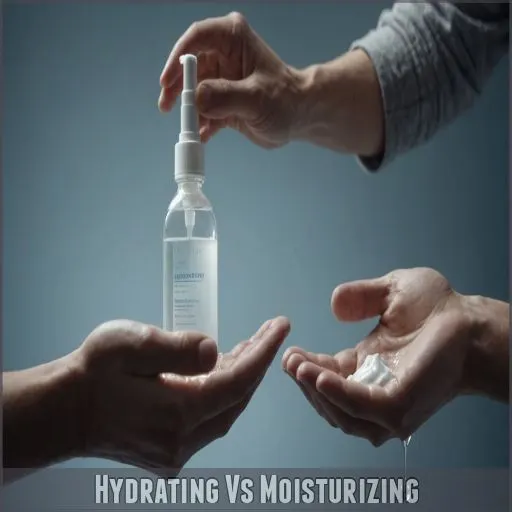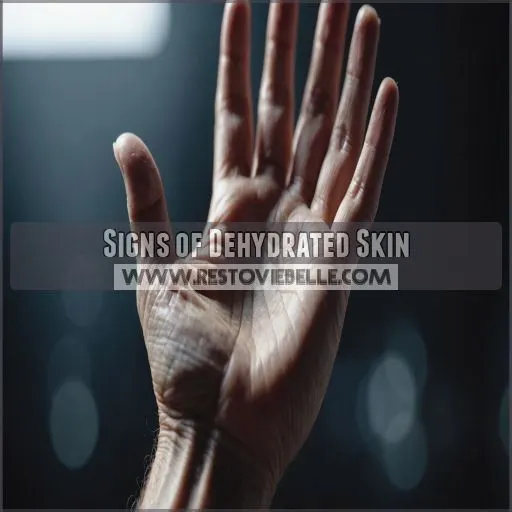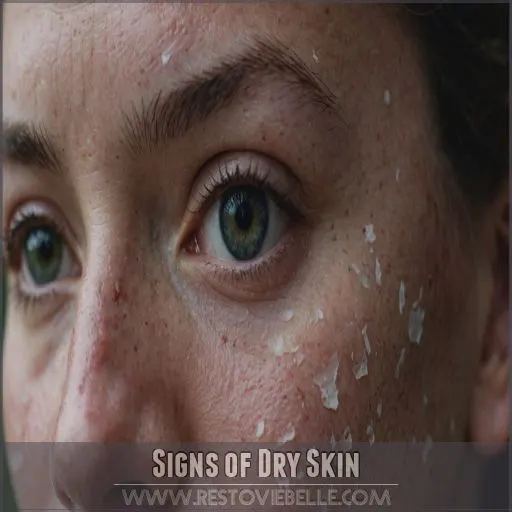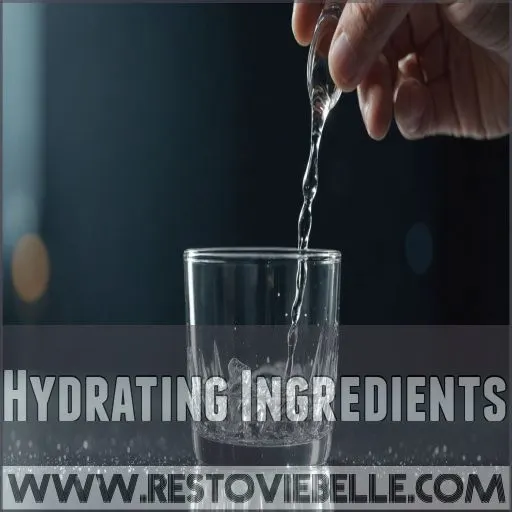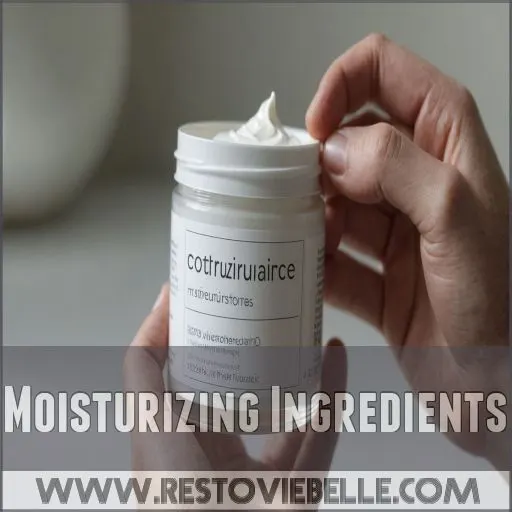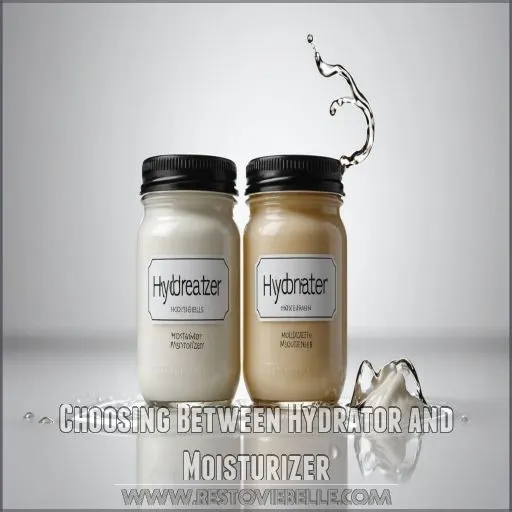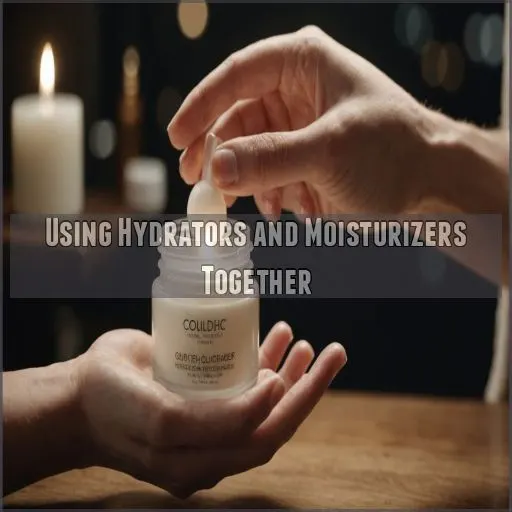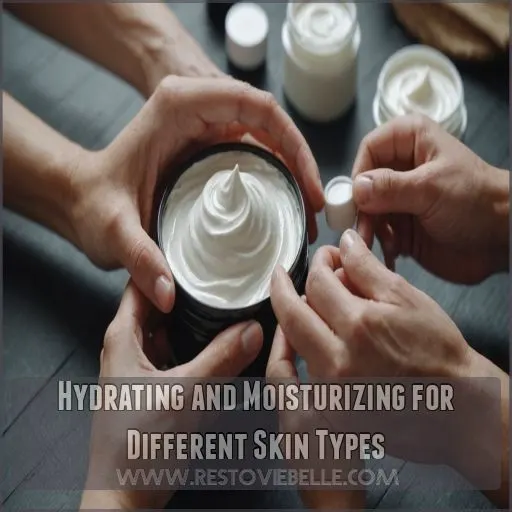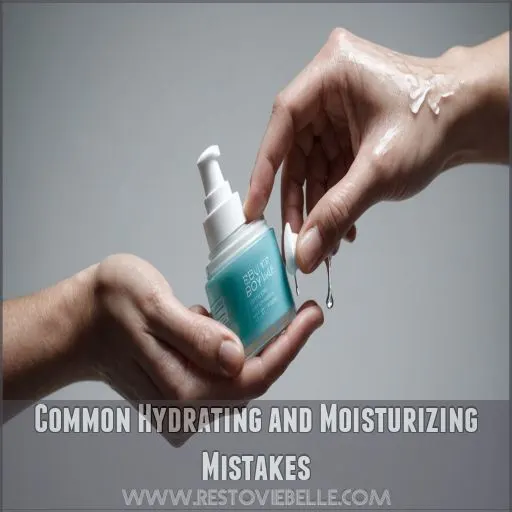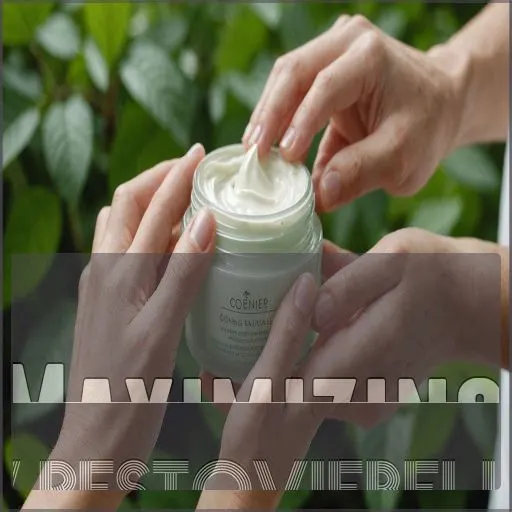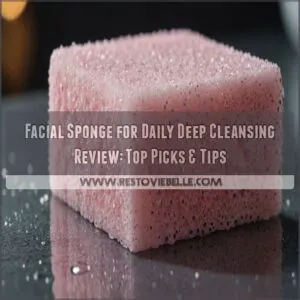This site is supported by our readers. We may earn a commission, at no cost to you, if you purchase through links.
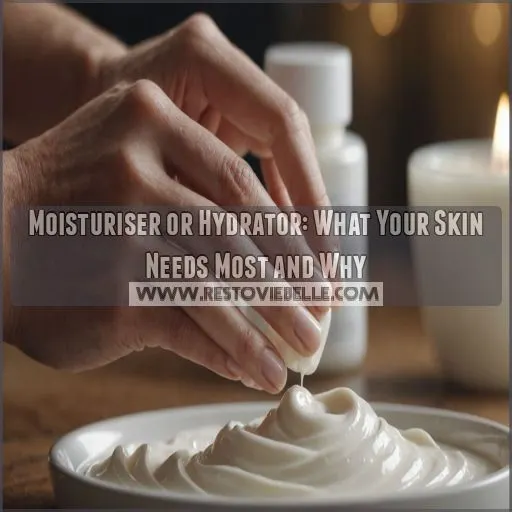
Think of hydrators as your skin’s water bottle, quenching its thirst with ingredients like hyaluronic acid.
Moisturizers, on the other hand, are like a cozy blanket, locking in that precious hydration with emollients and occlusives.
Your skin might need one or both, depending on whether it’s feeling dry (lacking oil) or dehydrated (lacking water). The key is figuring out what your skin’s crying out for – is it begging for a drink or craving a protective barrier?
Stick around, and we’ll spill the tea on decoding your skin’s secret language, to determine what it’s really craving – a drink or a protective barrier.
Table Of Contents
- Key Takeaways
- Hydrating Vs Moisturizing
- Signs of Dehydrated Skin
- Signs of Dry Skin
- Hydrating Ingredients
- Moisturizing Ingredients
- Choosing Between Hydrator and Moisturizer
- Using Hydrators and Moisturizers Together
- Hydrating and Moisturizing for Different Skin Types
- Common Hydrating and Moisturizing Mistakes
- Maximizing
- Frequently Asked Questions (FAQs)
- Which is better moisturizer or hydrator?
- Should I hydrate or moisturize?
- Should I use both hydrator and moisturizer?
- Do you put moisturizer or hydrator first?
- How long does facial moisturizer take to absorb?
- Should oily skin types use a facial moisturizer?
- Is it necessary to wash off facial moisturizer?
- Whats the best product to apply on face overnight?
- Can moisturizing cream be used on the face?
- Conclusion
Key Takeaways
- You’re not stuck choosing between a moisturizer and a hydrator – they’re like peanut butter and jelly, better together. Hydrators quench your skin’s thirst, while moisturizers lock in that goodness.
- Your skin type is your skincare compass for choosing the best toners for men
. If you’re feeling tight and flaky, you might need a moisturizer. If your skin looks dull and fine lines are popping up, reach for a hydrator.
- Don’t be afraid to layer up! Apply your hydrator first, then seal the deal with a moisturizer. It’s like giving your skin a moisture sandwich – delicious and effective.
- Consistency is key. Sticking to your skincare routine is like going to the gym – show up regularly, and you’ll see results. Your future self (and skin) will thank you for the dedication.
Hydrating Vs Moisturizing
You’re probably wondering if your skin craves a hydrator or a moisturizer and why it even matters.
Think of hydration like a glass of water for thirsty skin,
while moisturizers act like a cozy blanket locking in all that goodness.
What’s the Difference Between Hydrating and Moisturizing
Think of your skin as a thirsty houseplant. Hydration adds water to skin cells, plumping them up like a freshly watered bloom.
Hydrating ingredients, such as hyaluronic acid, draw water in, while moisturising ingredients, like occlusive oils, seal it tight.
Moisturizing, on the other hand, locks in that precious water, acting like a cozy blanket to prevent escape. Choose products suited to your skin type for a balanced, glowing complexion (Source).
How Hydrating and Moisturizing Work Together
Imagine hydration and moisture as a dynamic duo for your skin. Hydration, with hyaluronic acid, retains water, plumping it up and reducing the appearance of fine lines, while also providing immediate hydration. Hyaluronic acid is suitable for all skin types, especially dry and sensitive skin, making it a great addition to your skincare routine.
They’re like peanut butter and jelly—better together. Moisture, using shea butter or almond oil, locks it in, protecting the skin barrier.
Don’t skip this step: layer a hydrator, then smoother with a moisturizer. Customize your routine using lactic acid or cocoa butter for that dewy, complex everyone craves.
Signs of Dehydrated Skin
Ever wonder why your skin looks like you’ve spent a week in the desert, even when you haven’t been outside much?
If your once vibrant face feels more like sandpaper, it’s probably time to think about whether dehydration is the culprit.
Dullness and Lack of Radiance
Lost your skin’s radiant glow with hyperpigmentation best moisturizer for black skin
? That’s a sign of dehydrated skin.
Reclaim control by revamping your skincare routine. Try these tips:
- Use moisturizers with light-reflecting pearls and rosat extract to boost luminosity.
- Incorporate propylene glycol into your regimen for added hydration.
- Seal moisture with coconut or jojoba oil to repair the skin barrier.
You’ll soon banish that lackluster complexion!
Shadow-y and Sallowness
Noticing your skin lacks its usual glow?
A shadowy, sallow tone might be telling you it’s thirsty. Dehydrated skin often appears dull and can resemble dead grass in color.
Reach for a hydrator or moisturiser with olive leaf or colloidal oatmeal and niacinamide serum using ceramides together to boost skin health and regain that healthy radiance
. It’s like giving your skin a drink!
Emphasized Fine Lines and Wrinkles
Shadows and sallowness steal your glow, but fine lines and wrinkles might scream dehydration even louder.
Dehydrated skin emphasizes these lines, making you look older than you feel.
Combat this by amping up your hydration game. Reach for products with alpha hydroxy acid, bifidus prebiotic, and marshmallow root, while drinking coconut water—your skin’s thirst-quencher for restoring that youthful bounce.
How to Check if Your Skin is Dehydrated
Fine lines can tell tales, but they might also whisper your skin’s thirst. To check if your skin is dehydrated, try the pinch test: lightly squeeze your cheek. If it doesn’t bounce back quickly, your skin needs hydration.
Additionally, dry skin can be caused by environmental factors such as cold weather and low humidity, which can lead to moisture loss and increased skin irritation. Over-washing can also strip your skin of its natural oils, leading to dryness.
Dull texture, patchy makeup application, and loss of skin elasticity are red flags. Consider using products with plant oils or algae extract for relief.
Signs of Dry Skin
If your skin feels tight or resembles a lizard’s rough texture, you might need to rethink your skincare routine.
Dry skin can sneak up with flakes, peeling, or even cracks that cry out for extra moisture.
Tightness and Rough Texture
Feeling your skin tight and rougher than a cat’s tongue? You’re not alone; it’s a sign your skin barrier needs TLC.
Consider these:
- Moisturizing tips using hyaluronic acid.
- Exfoliation benefits with gentle scrubs.
- Product recommendations for intense repair.
- Essential oils like jojoba or argan for hydration.
- Dry skin causes like harsh soaps or cold weather.
These steps can help restore comfort and smoothness.
Flakiness, Peeling, Scaling And/or Cracks
Cracks and flakes might seem harmless, but they’re your skin’s SOS signals screaming for help.
With a dry skin parade featuring peeling skin treatment, scaling skin care, and cracked skin remedies, you’ll need a solid game plan.
Check this out:
| Issue | Possible Cause | Solution |
|---|---|---|
| Flakiness | Cold weather | Moisturize daily |
| Peeling | Sun damage | Use SPF |
| Scaling | Psoriasis | Seek dermatologist |
| Cracks | Lack of hydration | Drink water |
| Itchiness | Allergies | Avoid irritants |
Time to give your skin what it craves!
How to Check if Your Skin is Dry
Wonder if your skin’s dry? Try the pinch test. Lightly pinch some skin—if it doesn’t bounce back, dryness might be your culprit.
Notice flaking or irritation? You could be dealing with dry skin. Skin texture feels rough like sandpaper? Bingo! It’s dry.
Don’t worry, you’re not alone; almost everyone faces this desert-effect at some point. Keep moisturizing!
Difference Between Dry and Dehydrated Skin
You may have noticed your skin feeling tight, flaky, or irritated – that’s a sign of dry skin.
Unlike dehydrated skin, which lacks water, dry skin lacks natural oils.
Look for scaly appearance, white flakes, redness, and increased skin conditions like eczema.
To combat dry skin, focus on moisturizing with emollient-rich products.
Hydrating Ingredients
When your skin’s feeling like a parched desert, humectants are your best friends, pulling in moisture to keep things plump and bouncy.
Picture hydrating ingredients like glycerin or hyaluronic acid as the ultimate thirst quenchers for your skin, ready to transform that dry spell into a dewy glow.
What Are Humectants and How Do They Work
Think of humectants as thirsty sponges for your skin, drawing water from the air and deeper layers to maintain moisture balance.
These skincare gems, like glycerin and hyaluronic acid, utilize their hygroscopic properties to enhance skin hydration.
Whether it’s glycerin or aloe vera, different humectant types cater to varied needs, ensuring your skin stays plump and youthful.
Embrace humectants for that dewy, freedom-loving glow you truly deserve!
How to Incorporate Hydrating Ingredients Into Your Skincare Routine
Hydrating with humectants like hyaluronic acid can transform your skin into a sponge. Embrace these humectant benefits effortlessly by following these hydration tips:
- Use Hydrating Serums: Apply before moisturizing to lock in moisture like a pro.
- Try DIY Masks: Mix aloe vera with glycerin for a home spa moment.
- Explore Essences: These secret potions enhance the skin’s ability to soak up other products like sunshine.
Moisturizing Ingredients
You’re staring at your skincare shelf, wondering if your moisturizer’s doing its job.
Moisturizing ingredients like petrolatum and shea butter seal in moisture, making your skin feel as soft as a baby’s cheek.
What Are Emollients and Occlusives
Underneath the surface of your skincare routine, two key players, emollients and occlusives, work their magic.
Emollients, filling in gaps between skin cells, provide softness and smoothness, like a well-played melody. Ceramides and dimethicone are popular examples boasting a host of benefits (Source).
Occlusives, on the other hand, act as a moisture barrier, locking it in tight. Think of petrolatum as a skin superhero, ready to shield your hydration.
How to Incorporate Moisturizing Ingredients Into Your Skincare Routine
Moisturizing ingredients are your skin’s BFFs, ensuring it stays as soft as a marshmallow. Start by identifying your skin type to choose the right products.
Consider combining gentle ingredients like azelaic acid Combining Acne Fighters, which works well with other moisturizing ingredients to soothe and calm the skin. Linoleic acid can also be beneficial in strengthening the skin barrier and reducing inflammation.
Layer ’em like a pro with these routine tips:
- Use moisturizers with ceramides and hyaluronic acid.
- Try a DIY recipe using natural oils like coconut oil face serum recipes
.
- Pick a product recommended for your skin concerns.
- Don’t forget those under-eye creams!
- Always apply to slightly damp skin for best absorption.
Happy moisturizing!
Choosing Between Hydrator and Moisturizer
Trying to figure out if your skin needs a hydrator or a moisturizer?
Don’t sweat it – we’ve got you covered.
The key is understanding your unique skin type and how different ingredients work to quench its thirst or lock in that precious moisture, which is where a hydrator or a moisturizer comes in.
How to Determine Your Skin Type
Ever wondered what your skin is trying to tell you? Jump into a skin type quiz or skin type assessment to decode the mystery! Knowing your skin type helps you choose between a hydrator or a moisturizer.
When searching for the right product, look for key ingredients like hyaluronic acid, niacinamide, and glycerin to lock in moisture and soothe dry skin Natural Ingredients for Skin.
Oily T-zone, dry areas
Try a skin type test for clarity!
Can You Use Both a Hydrator and a Moisturizer
You’ve nailed down your skin type—bravo! Now, let’s tackle the fun part.
Can you use both a hydrator and a moisturizer? Absolutely! Think of it as a dynamic duo for your skin.
While the hydrator pulls in moisture with humectants like hyaluronic acid, the moisturizer locks it in, forming a protective barrier.
Tailor your routine to suit your skin’s needs and enjoy the benefits of layered hydration and moisture.
Using Hydrators and Moisturizers Together
You might think choosing between a hydrator and a moisturizer is a tough call, but here’s a secret: your skin actually loves both!
Combining them can give you the best of both worlds—plump, hydrated skin and a smooth, soft finish that keeps you looking fresh.
Even if your day’s been as wild as the squirrels in your backyard, you can still maintain a smooth, soft finish.
How to Layer Hydrators and Moisturizers
Your skin’s thirst-quenching routine starts with hydrators, followed by moisturizers. Think of it as building a moisture sandwich.
Hydrating tonics like the Hyaluron SwissCode Pure Daily Moisturising Tonic can also help provide an extra layer of hydration. For example, using a hydrating gel cream like the Hada Labo Tokyo Skin Plumping Gel Cream can also help lock in moisture similar to a good bald head moisturizer
.
In your morning routine, apply your hydrating serum first, then layer on your moisturizer. At night, repeat the process, but consider using a richer cream.
Remember, consistency is key – stick to this layering tip, and you’ll be on your way to dewy, plump skin in no time.
Benefits of Using Both Hydrators and Moisturizers
Now that you’ve mastered layering, let’s explore the dynamic duo of skincare. Using both hydrators and moisturizers is like giving your skin a one-two punch of nourishment. They work in tandem to create a powerhouse of skin health. Hydrators quench your skin’s thirst, while moisturizers seal the deal.
Picture your skin:
- Plump as a ripe peach
- Smooth as silk sheets
- Glowing like a firefly on a summer night
This tag-team approach boosts hydration impact and strengthens your skin’s barrier function.
Tips for Customizing Your Hydrating and Moisturizing Routine
Let’s tailor your skincare routine to fit like a glove! Start by identifying your skincare goals – are you battling dryness or seeking that dewy glow?
Layer products wisely, applying hydrators before moisturizers. For seasonal adjustments, swap lightweight gels in summer for richer creams in winter.
Try DIY masks for an extra boost. Morning routines focus on protection, while nighttime is all about repair and rejuvenation.
It’s your skin’s time to shine!
Hydrating and Moisturizing for Different Skin Types
Your skin’s as unique as your fingerprint, so it’s time to tailor your hydration game.
Let’s figure out how to quench your skin’s thirst, whether it’s dry as the Sahara or oily enough to fry an egg.
Hydrating and Moisturizing for Dry Skin
For dry skin, it’s time to double down on hydration and moisture.
Don’t fall for dry skin myths – your skin’s thirsty, not just parched on the surface.
Embrace a winter routine with the best products: thick, greasy moisturizers are your new best friends.
Layer on hydrating serums with hyaluronic acid, then seal the deal with natural oils or petroleum jelly.
Think of it as wrapping your skin in a cozy, moisturizing blanket.
Hydrating and Moisturizing for Oily Skin
Many oily-skinned folks fear moisturizing, thinking it’ll turn their face into an oil slick.
But here’s the skinny: your skin craves hydration too! Opt for lightweight, oil-free hydrators packed with hyaluronic acid.
They’ll quench your skin’s thirst without clogging pores. For a matte finish, look for products with oil-absorbing microspheres.
Balance is key – hydrate to control oil, not fight it!
Hydrating and Moisturizing for Sensitive Skin
Sensitive skin needs extra TLC. Unlike oily skin, it’s prone to irritation from common ingredients. You’ll want to look for moisturizers with ceramides and hyaluronic acid to strengthen your skin barrier.
Stick to fragrance-free, hypoallergenic products that won’t trigger a reaction.
Remember, gentle cleansing is key. Think of your skin like a delicate flower – it needs nurturing, not harsh treatment.
Your skincare routine should be a soothing ritual, not a battle.
Common Hydrating and Moisturizing Mistakes
You’re not alone if you’ve been slathering on creams without seeing results. Let’s tackle those sneaky skincare slip-ups that might be sabotaging your quest for that dreamy, dewy glow.
Not Being Consistent With Your Skincare Routine
You’ve got your skincare routine down pat for your skin type, but here’s the kicker: consistency is the secret sauce. Think of your skincare routine like a gym membership – showing up once in a blue moon won’t cut it.
Your skin cells are on a 30-day cycle, so it takes time to see results . Skipping days or changing products like you change your mind about what to watch on Netflix can throw your skin for a loop.
It’s like trying to hit a moving target – you’ll never quite nail it. Stick to your routine like glue, even when your skin looks picture-perfect.
Prevention is easier than playing catch-up. Make it a habit, like brushing your teeth. Pair it with daily activities to keep yourself on track.
Your future self (and skin) will thank you.
Maximizing
Now that you’ve got the lowdown on hydration and moisturizing, let’s crank it up to eleven! Maximizing your skin’s hydration benefits is like finding the perfect dance partner for your complexion, just like incorporating antioxidant rich foods into your diet
.
To get the most out of your products, try these smooth moves:
- Layer like a pro: Start with a hydrating toner, then slap on that serum before sealing the deal with a moisturizer.
- Time it right: Apply your hydrator to damp skin – it’s thirsty and ready to drink up all that goodness.
- Don’t skimp on sunscreen: It’s not just for beach days! Sunscreen helps lock in moisture and protect your skin barrier.
- Mix and match: Combine humectants with occlusive agents for a power duo that’ll keep your skin hydrated and glowing.
Remember, your skin is as unique as your fingerprint. Play around with different combos until you find your perfect match. Your skin will thank you with a radiant, healthy glow!
Frequently Asked Questions (FAQs)
Which is better moisturizer or hydrator?
Both have their perks! Moisturizers seal in hydration, while hydrators attract water to your skin.
Think of moisturizers as cozy blankets and hydrators as water magnets.
Your skin’s needs determine which is better for you.
Should I hydrate or moisturize?
Ideally, do both!
Hydrate to quench thirsty skin cells, then moisturize to lock it in.
Think of it like drinking water, then sealing your lips.
Your skin craves this double-whammy for that healthy, dewy glow.
Should I use both hydrator and moisturizer?
Using both hydrators and moisturizers is like giving your skin a one-two punch of care.
Hydrators quench your skin’s thirst, while moisturizers lock in that goodness.
It’s a dynamic duo for healthy, glowing skin.
Do you put moisturizer or hydrator first?
Apply hydrator first, then moisturizer.
Think of it like layering clothes: hydrator’s your base layer, drawing water in, while moisturizer’s the cozy jacket on top, sealing everything in.
This combo keeps your skin plump and protected.
How long does facial moisturizer take to absorb?
Like a sponge soaking up water, your skin absorbs moisturizer gradually.
It typically takes about 30 minutes for full absorption (Source).
Give each product a minute to settle before layering, ensuring maximum benefits without pilling.
Should oily skin types use a facial moisturizer?
Even oily skin craves hydration.
A lightweight, water-based moisturizer balances oil production, preventing the skin from overcompensating.
It’s like giving your face a good drink, keeping it healthy and less prone to breakouts.
Is it necessary to wash off facial moisturizer?
Ever wondered if you’re doing skincare wrong?
Relax, you don’t need to wash off facial moisturizer. It’s designed to absorb into your skin, providing lasting hydration.
Let it work its magic overnight or throughout the day.
Whats the best product to apply on face overnight?
Night creams pack a powerful punch for your skin while you snooze.
Look for ingredients like retinol, hyaluronic acid, or niacinamide.
Kiehl’s Ultra Facial Overnight Hydrating Mask or CeraVe PM Facial Moisturizing Lotion are great choices for overnight pampering.
Can moisturizing cream be used on the face?
While body lotions pamper your limbs, facial moisturizers are your skin’s best friend.
They’re specially formulated to hydrate delicate facial skin without clogging pores.
Choose one that suits your skin type for a glowing, nourished complexion and remember to select a moisturizer that is specially formulated.
Conclusion
In the world of skincare, there’s no one-size-fits-all solution.
The choice between a moisturiser or hydrator boils down to your skin’s unique needs. Listen to what your skin’s telling you – is it thirsty for hydration or craving a protective barrier?
Remember, you can use both if needed. The key is finding the right balance.
So, don’t be afraid to mix and match until you find your perfect skincare cocktail. Your skin will thank you with that healthy, radiant glow we’re all after, and your skin will thank you.

